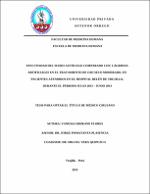Efectividad del suero autólogo comparado con lágrimas artificiales en el tratamiento de ojo seco moderado, en pacientes atendidos en el hospital Belén de Trujillo, durante el periodo Julio 2013 – Junio 2014

View/
Download
(application/pdf: 448.5Kb)
(application/pdf: 448.5Kb)
Date
2015Author(s)
Ishikane Flores, Vanessa
Metadata
Show full item recordAbstract
Determinar y comparar la efectividad del suero autólogo frente a lágrimas artificiales en el tratamiento de ojo seco según test de Schirmer, TBUT y OSDI. Material y Métodos. Se realizó un estudio analítico, observacional de cohortes prospectivas, realizado en el Hospital Belén de Trujillo de Julio 2013 - Junio 2014. Nuestra población de estudio se limitó a 64 pacientes con ojo seco, siendo considerados 32 pacientes en cada cohorte. Se aplicó lágrimas artificiales (Hialuronato de sodio al 0.4%) a la primera cohorte, y suero autólogo al 20% a la segunda cohorte. Se utilizó el test de chi cuadrado para establecer la relación entre variables cualitativas tomadas en cuenta: Los tipos de tratamiento y la efectividad del tratamiento. Para comparar la efectividad entre los dos tipos de tratamiento se aplicó la prueba de comparación de proporciones. Resultados. El promedio de edad de los pacientes atendidos fue de 59.4 años (rango de 45 a 90 años) con una desviación estándar de 9.51 años. La distribución de los pacientes según el sexo fue: sexo femenino 49 (77%) y sexo masculino 15 (23%). Hubo una mejoría con el uso de suero autólogo según Schirmer de 62.5% y según TBUT 68.75%; mientras que con el uso de lágrimas artificiales hubo una mejoría según Schirmer de 18.75% y según TBUT 12.5%. La efectividad del tratamiento con suero autólogo según OSDI fue, grado leve: 75%, moderado: 18.75% y severo: 6.25%; mientras que del tratamiento con lágrimas artificiales fue, grado leve: 15.62%, moderado: 46.88% y severo: 37.5%. La efectividad global según tratamientos fue de la siguiente manera: 65.62% en pacientes tratados con suero autólogo y 34.38% en pacientes tratados con lágrimas artificiales. Conclusiones. El suero autólogo es más efectivo que las lágrimas artificiales en el tratamiento del ojo seco. To determine and compare the effectiveness of autologous serum against
artificial tears in the treatment of dry eye according to Schirmer test, TBUT and OSDI.
Material and Methods. An analytical, observational prospective cohort study performed at
Belen’s Hospital of Trujillo was conducted in July 2013 - June 2014. Our study population
was limited to 64 patients with dry eye, being considered 32 patients in each cohort.
Artificial tears (sodium hyaluronate 0.4%) were applied to the first cohort, and 20% serum
autologous to the second cohort. The chi square test was used to establish the relationship
between qualitative variables taken into account: The types of treatment and treatment
effectiveness. To compare the effectiveness between the two types of treatment comparison
test of proportions was applied. Results. The average age of patients treated was 59.4 years
(range 45-90 years) with a standard deviation of 9.51 years. The distribution of patients by
sex was: Female 49 (77%) male and 15 (23%). There was an improvement with the use of
autologous serum according Schirmer 62.5% and 68.75% according TBUT; while with the
use of artificial tears there was an improvement according Schirmer 18.75% and 12.5%
according TBUT. The effectiveness of treatment with autologous serum as OSDI was mild
75%, moderate: 18.75% and severe: 6.25%; whereas treatment with artificial tears was
mild: 15.62%, moderate: 46.88% and severe: 37.5%. The overall effectiveness as
treatments was as follows: 65.62% in patients treated with autologous serum and 34.38% in
patients treated with artificial tears. Conclusions. Autologous serum is more effective than
artificial tears in the treatment of dry eye.
Subject
Collections
- Medicina Humana [2969]

